At a Glance: The Quest Kids
Designer: Dustin McMillian
Publisher: Treasure Falls Games
Artist: Apolline Etienne
Player Count: 2-4
Suggested Age: 5+
Playing Time: 20-45 minutes
Theme: Fantasy, Children
Mechanics: Hand Management, Exploration
Find more about The Quest Kids by visiting Treasure Falls Games online on Facebook and Instagram, and purchase the game on their website!
“I’m going on an adventure!”
― Bilbo Baggins, The Hobbit (Film)
Intro Story: The Cave of Tolk the Wise
Ivy crouches next to the cave’s entrance, long, pointed elf-ears listening for noise. “Sounds clear,” she says to her friends. Skylar, Noah, and Crash shuffle, nervous, but otherwise eager to explore old Tolk’s cave. Tolk the Wise, he was called, but how wise can a guy be if he disappears without a trace?
Nobody from Treasure Falls has heard from the old wizard since he disappeared a number of years ago, but most haven’t given it much thought, much less considered exploring the cave.
Crash, the young wizard wearing a yellow robe and a pointed-yellow hat embroidered with grey stars, pushes forward. “Let’s go, then!”
“Not so fast!” Ivy cautions. She slowly opens the door, peeking in, but not seeing anything startling. She pushes the door open the rest of the way and walks in, Crash on her heels, followed by Skylar and Noah.
“Whoa…” Noah says, taking in the large entrance. Crystals, growing from the ground and walls, shimmer in some mystic light, the source unseen by the young adventurers.
“This is awesome!” Skylar says, her voice echoing in the mostly empty chamber.
The group walks around, taking everything in. Ivy sees something at her feet and bends to pick it up. She stands upright, holding a glittering bag that is seemingly full of coins. With her discovery, the four children scurry around, trying to find more treasure hidden in nooks and crannies. As they venture from the entrance to the main chamber, Ivy hears a low rumble. She hushes her group, and they stop moving and chattering immediately. The noise comes again, this time closer.
“What is it?” Noah hisses.
“Baddies,” Ivy says. Lots of them.
“So this is where they all ran off to,” Skylar says. “We need to be careful.”
“Should we leave?” Crash asks. “Wait for the adults?”
“Nah,” says Ivy. “We can take them. Besides, I have an idea.”
Together, the four young heroes sneak through the cave, hiding in the shadows cast by lit torches hanging on walls. Crash casts a quiet spell, and smoke begins to emanate from his hand. Skylar scratches on the stone wall, and Ivy patters loudly through the now-thick smoke, laughing manically.
All other sounds stop, and Ivy can see the outlines of shapes—pirates, she realizes—staring at her silhouette in the smoke. After a few more eerie laughs and some frantic flailing, is a mad scuffling as a host of boots race for the exit. Silence follows. Finally, Ivy giggles, pleased with the way they scared off the plundering pirates.
“I can’t believe that actually worked!” Noah exclaims.
“Now we can get back to exploring,” Ivy says with a grin. “Just be careful, because who knows what else is lurking in this old, dusty place.”
Sticking close together, the four young heroes of Treasure Falls continue exploring, eager to find the secrets of Tolk’s cave.
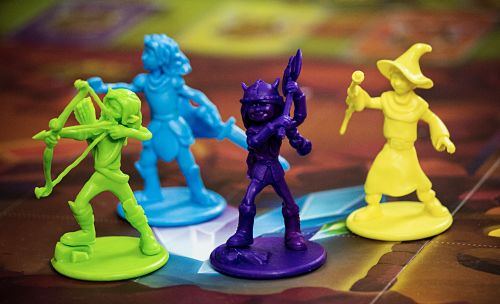
Note: I was provided a complimentary copy of The Quest Kids for the purpose of review. The thoughts and opinions in this review are my own.
Overview/Roadmap
This review has two parts. First, there is the Short Review, where various aspects of the game are discussed. Then comes the Gameplay Review, in which the setup and gameplay are discussed in detail, along with initial thoughts. Following the Gameplay Review section are some final thoughts and a final verdict of the game. Feel free to jump around, or read it all in one go.
About My Kids
The Quest Kids is geared toward young children (ages 5+), so it’s important you know a little bit about my kid in order to know if this game might work for your little ones.
I have three children, two of which are old enough to play this. The boys, ages 4 and 5 (6 in a few months, as of this writing), love games. My oldest plays anything from Guess Who to My Little Scythe to Forbidden Island to Herbaceous to anything we’ll let him play, really. He lives and breathes games, and he will play them as often as he can. My four-year-old, however, struggles to finish games that are too involved. He enjoys My First Orchard, Crokinole (and he is very good at it), My First Castle Panic, and other games where there are few rules.
I was interested, then, to see how appealing The Quest Kids would be to a kid who will do anything to play a game, and to one who really struggles to find games engaging. Spoilers: I was pleasantly surprised on both sides of the spectrum.
Short Review
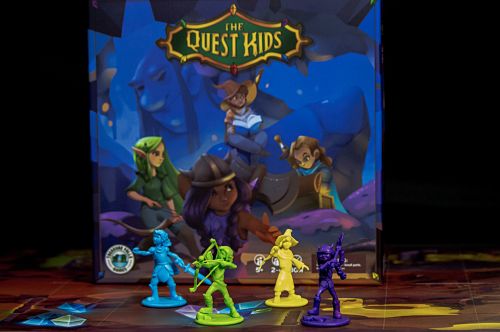
The Quest Kids is a simple dungeon crawler—potentially your kids’ first one! Throughout the game, players move their characters through the dungeon, revealing dungeon cards that either provide good things, or a bad guy (or girl). The good things are cards (that help defeat baddies as well as gain gems) and treasure tokens. The baddies can be anything from a measly little pirate guy to a big, bad dragon. Players can help each other by giving needed cards, and in return they gain a Kind Kid card which provides some sort of perk. The end of game is triggered when all of the dungeon cards have been revealed.
Immersion
The opportunity to explore a dungeon, along with the possibility of uncovering a good or bad thing, is probably one of the most exciting parts for my kids. They love it. And, admittedly, so do I. Needless to say, the immersion factor of The Quest Kids is high for my kids. They’re into it throughout the entire game, and for my four-year-old especially, that is something worthy of note.
Theme

The fantasy-theme dungeon delve is a great theme for kids, but it’s the art and style of the characters and baddies that helps sell the game for the kids. The baddies are certainly dangerous, but come with a cartoony air to them that’s reminiscent to what one might find in a Saturday morning cartoon. The theme is spot on for kids.
Components
The game consists of a lot of cards, which do feel somewhat flimsy, but honestly they haven’t been a problem. The miniatures that come with the game are wonderful and really add to the overall theme of the game. All in all, the components are pretty good. Nice, solid game board, cardboard tokens, and a plethora of cards.
Standout Performances
- Engaging theme
- Simple rules
- Encourages players to help others
- Age-appropriate gameplay
Breaking the 4th Wall
In theater, breaking the fourth wall refers to when characters (or something else) directly address the audience, thus pulling them out of the narrative and making the astutely aware that they are, in fact, watching a performance and that’s it’s not actually real.
The game is pretty easy to setup, but that’s not to say it’ll be easy for your kids. But, given a few chances to help and some encouragement as they do it on their own, they should be able to get the hang of it. I only mention this because if you want your kids to play by themselves, you may need to assist in setup. But it doesn’t take long to set it all up, and they should be able to get the hang of it quickly.
Gameplay Review

First Impressions
First impressions matter, and, fortunately, my kids were met with chivalry and grace. Meaning, it was a good first impression. With simple rules and engaging gameplay, The Quest Kids certainly made a good first impression.
Setup

With the board in the middle of the table, fill each square with a dungeon “tile” (I.e. card). The far right side gets all of the red cards, and the rest of the dungeon map is filled with a random mix of green and grey cards. Players select a character and take the miniature and player board, along with the starting card that goes along with that character. (See the setup instructions in the rules for more details.) Each character gets three heart cards, a quest card, and you’re ready to go!
The Quest Kids Gameplay
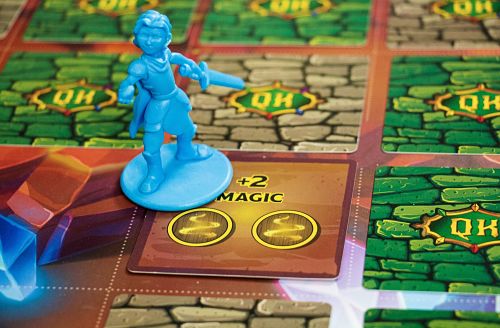
Players take turns moving their character tokens/miniatures to an available dungeon card (i.e. adjacent to an empty space or an already revealed dungeon card) and flip it over. If it’s good, you’ll get the benefits shown on the card, including ability cards (used to defeat baddies and collect gems) and treasure tokens. If it’s a baddie, you will need to pay the cost shown on the card to defeat it (i.e. pay by discarding the appropriate ability cards).

If you cannot pay the cost, the other players are able to help by giving you the needed cards. For each card given, they receive a Kind Kid card, which gives them certain perks, such as treasure, health, and/or points. If you can’t afford the cost, and your valiant companions can’t (or won’t) help you, you lose a health card. Each health card also has points, so losing them could cost you. If you lose all of your health cards, you lose a turn, but get back in—with an additional health card—on your next turn.
The end of the game is triggered when all of the dungeon cards have been revealed. After that, all players get an extra two turns to revisit still-revealed dungeon cards that have not yet been resolved, including baddies and gems. When all players have finished taking their final turns, scores are counted by counting the number of stars acquired, including on baddie cards, health cards, Kind Kid cards, and treasure tokens.
When counting stars, if the character shown on the treasure tile matches your character, you get the bottom star value indicated on the treasure token. Otherwise, you get the top star value on the token. The player with the most stars wins!
Thoughts on Gameplay
The rules are simple, which is practically mandatory for a game geared for kids ages 5 and up. But there are other aspects of the game that really make it special. For example, The Quest Kids teaches teamwork—even as players try to get the most stars for themselves. I think it’s an important quality to showcase, especially as my oldest can sometimes struggle to find it within himself to help someone else get points when he knows he needs more to win.
The gameplay is fast and smooth, perfect for kids. And it was a hit from beginning to end, with the kids begging to play game after game. That’s a good sign of a good, age-appropriate game.
Final Thoughts on The Quest Kids
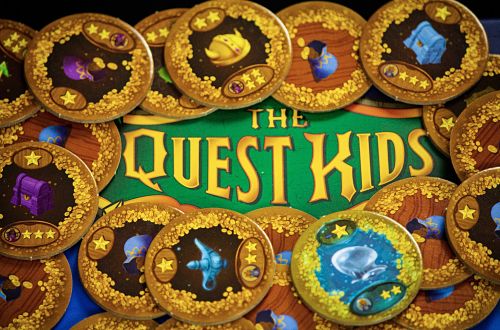
The Quest Kids is a solid game for kids, and it’s fun for us as parents to play with them as well. My oldest kid loves this game and is constantly asking to play it again and again. My four-year-old, who struggles to stay engaged during many games, consistently stays to the end of the game and loves every minute of it.
Whether it’s the theme, the mechanics, the art, or the combination of everything, there’s certainly something special about The Quest Kids. It’s a great game for kids, and I would highly recommend it to anyone looking for more games to play with their younglings.
Final Thoughts from the Kids
I asked my kids about The Quest Kids and, well, here are a couple of things they said.
Me: How did you like it?
4-Year-Old: Good.
Me: What made it good?
4-Year-Old: It was terrible with bad guys.
Me: What did you like about The Quest Kids?
5-Year-Old: Defeating the monsters and getting treasure.
Final Verdict
As this is a kid’s game, the final verdict will be derived from my kids’ reactions while playing, as well as our discussions after playing. From what I’ve observed, they are totally into it each and every time they play. They love the exploration, and they love being able to help others (or maybe they just love the Kind Kid cards, who knows).
Regardless, The Quest Kids is one of my new favorite games to play with my kids, and one of my kids’ new favorite games. Because of what I’ve witnessed, what I’ve heard, and their constant desire to play, my final verdict here is Captivating.
Verdict Scale (Lowest to Highest)
The Final Verdict is based on a scale of 1-7, although this scale is not numbered. Instead, it uses thematically appropriate words to describe the performance of the game.
Tomatoes – This game was emotionally taxing and difficult to finish.
Uninspiring – This game had me daydreaming about other games.
Lackluster – This game had its moments, but it probably won’t see much table time.
Laodicean – This game is decent. It works. There’s a reason people like it.
Two Thumbs Up – This game is very good.
Captivating – This game is outstanding! It’s more than good; it’s practically a staple.
Standing Ovation – This is the best game you will ever play. Period.
Read short fiction inspired by board games at BGI’s stories page!
Find more about The Quest Kids by visiting Treasure Falls Games online on Facebook and Instagram, and purchase the game on their website!
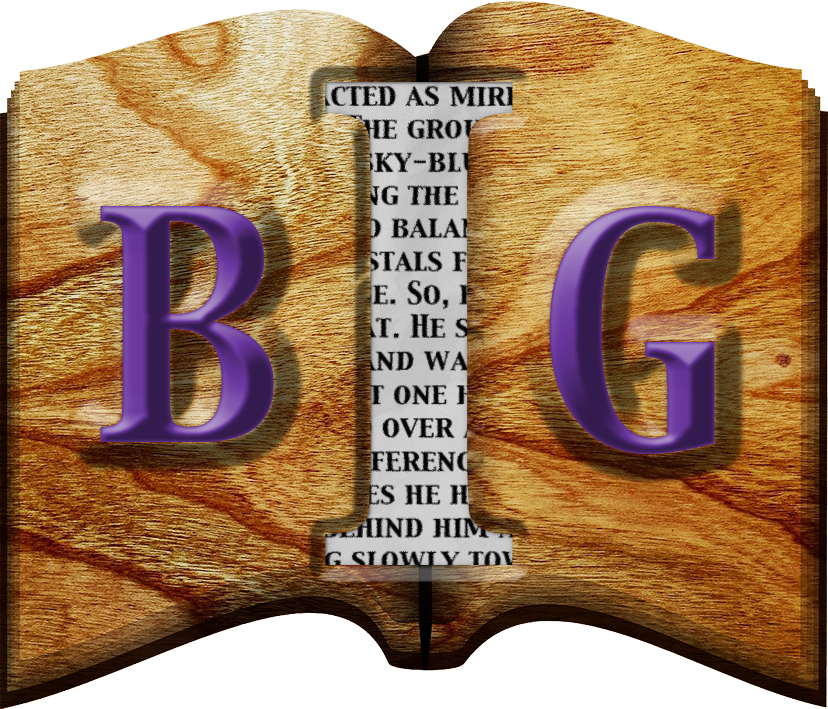

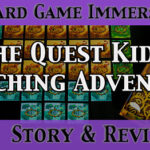
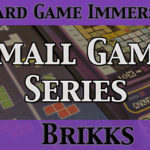
Pingback: The Quest Kids: Trials of Tolk the Wise Review - Board Game Immersion